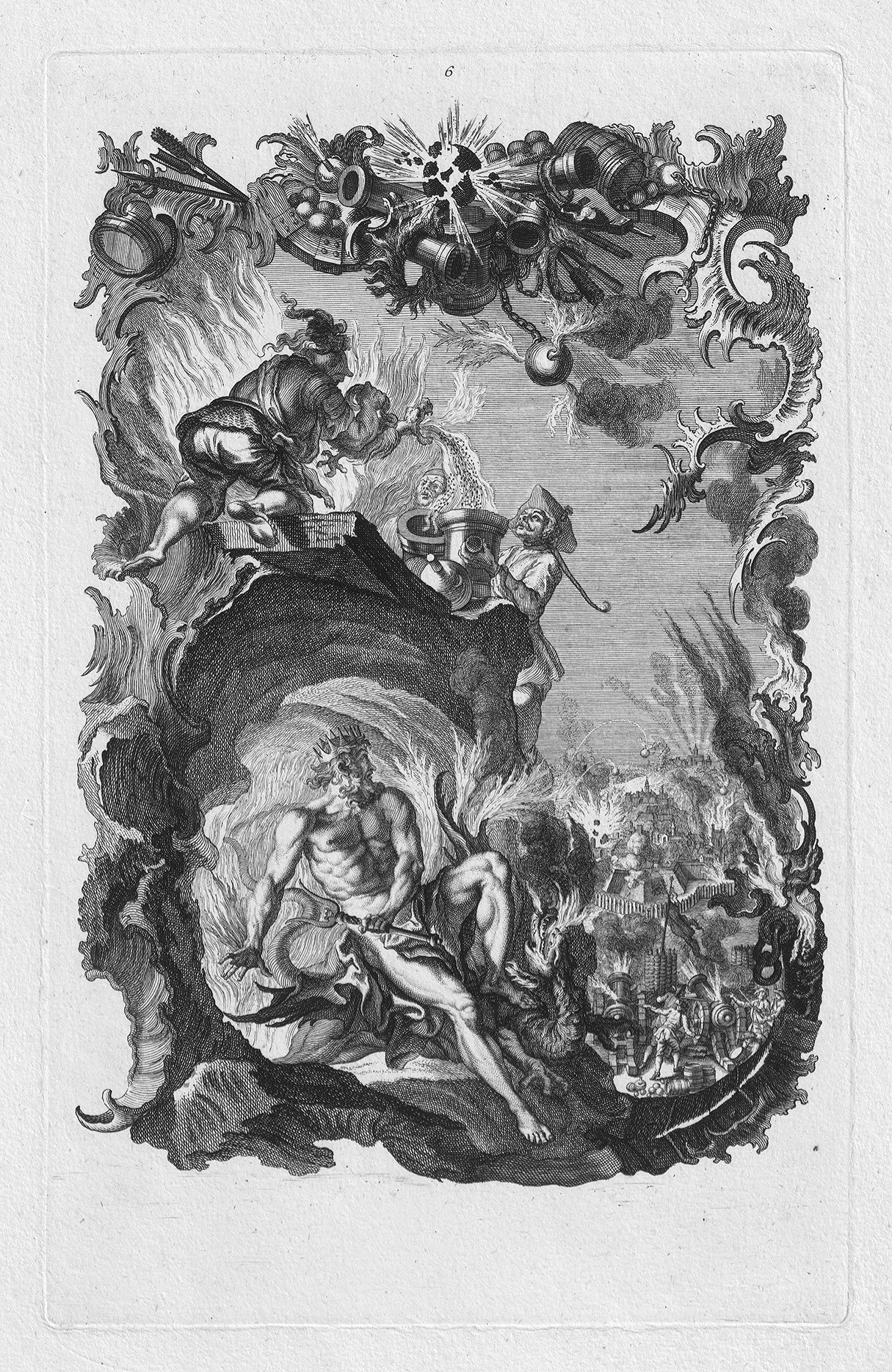Loading the page ...
Gottfried Bernhard Goetz
(or Göz, 1708 Welehrad – 1774 Augsburg)
The Horrors of War. Title page and seven engravings. Each approx. 34.2 x 21.2 cm. (1742). Wildmoser 1–340–001–8, each III; Berliner Ornamentstichkatalog 126, 1,2.
Having been apprenticed as a painter in Brno and made his way through Lower Austria as a journeyman, Gottfried Bernhard Goetz (Göz) arrived in 1728/29 in Augsburg, where he resolved to continue his studies. He soon joined the circle around Johann Georg Bergmüller, the Catholic director of the Augsburg Academy, and began working under his guidance as an engraver. Most of his designs at this time were based on works by Bergmüller or Joseph Anton Feuchtmayer, but it was not long before Goetz began making engravings from his own inventions. Around 1737 he joined the brothers Johann and Joseph Klauber in setting up a publishing company and shortly afterwards started issuing engravings himself, his company being granted an imperial privilege in 1742. Two years later he was awarded the title of imperial court painter and engraver.
Among the first works Goetz brought out in his own publishing house was the present suite of eight prints entitled The Horrors of War, which he engraved after his own preliminary drawings and dedicated posthumously to Emperor Charles VI, who had died two years earlier. This impressive cycle, which was to establish Goetz’s reputation as an engraver in Augsburg, was initially published in 1742 in two editions, the first before letters and the second with captions in German and Latin. During Goetz’s lifetime the Augsburg mezzotintist and publisher, Johann Simon Negges (1726–1792), acquired the plates from the artist and issued the series in a third, still contemporary edition – an indication of the tremendous popularity of this magnum opus. Of the preparatory drawings a total of five pen-and-ink drawings with grey wash have survived, three of which are in public collections (Berlin, Kunstbibliothek; Munich, Graphische Sammlung; and Nuremberg, Germanisches Nationalmuseum).
Having graced the title page with sumptuous rocaille ornamentation, Gottfried Bernhard Goetzuses the other seven prints in the series for a visually striking and highly dramatic portrayal of the horrors of war in scenes that are partly realistic and partly allegorical. The abundance of original imagery, manifest attributes and exuberant decorative patterns is simply overwhelming. Indeed, it is difficult for the beholder to know where to look first in the face of all this visual opulence. The Augsburg Rococo style has all but reached its zenith here. On the first print the viewer sees Bellona, the personification of War, bursting forth from a fiery gorge to murder Peace; Europe, personified by a graceful female figure, looks on in trepidation. On the fourth print of the series the personification of Earth lies exhausted amid the corpses of fallen soldiers and looks up at Death hovering ominously over the scene in the form of a winged skeleton in a suit of armour. That Peace is threatened not only on land is demonstrated by a naval battle, from which Neptune and his host of Nereids are forced to flee. The artist displays a meticulously detailed panorama of the whole pandemonium of war: “Woe, O Woe” savaged mankind groans, while insidious murderers loot, maraud and pillage.
The dramatic nature of the subject matter notwithstanding, the rich rocaille ornamentation injects a certain decorative lightness into the individual episodes, which perfectly reflects the refined aesthetic aspirations of the Rococo period. The organic, shell-shaped ornaments blend superbly into the respective scenes, highlight the different rock, water and tree formations or evaporate in clouds of smoke. Goetz first used this kind of picture framing in the mid-1730s. In 1741 he petitioned the Elector of Bavaria and the Palatinate to grant him a protective privilege for his printmaking “in a completely new, freely invented manner without a rectangular frame for the picture”. Goetz’s completely autonomously designed pictures without any engraved framing lines were, indeed, a novelty and the artist was finally granted the privilege he had applied for on 15 January 1742.
Goetz’s series of engravings on The Horrors of War was extremely popular in the 18th century and appeared in a total of three editions. Nonetheless, the suite is now of exquisite rarity and only a very few complete impressions have survived. Incomplete series are to be found in Berlin (Kunstbibliothek, Ornamentstichsammlung and Deutsches Historisches Museum). We were able to verify complete series in Augsburg (Kunstsammlungen und Museen), Munich (Graphische Sammlung) and New York (The Metropolitan Museum, the third edition by Negges on offer here). The suite is not present in Nuremberg.
Superb, harmonious and homogeneous impressions, printed on the full sheet of paper. Minor ageing, otherwise in mint condition. Literature: Rudolf Wildmoser, “Gottfried Bernhard Goetz (1708–1774) als ausführender Kupferstecher: Untersuchung und Katalog der Werke”, in: Jahrbuch des Vereins für Augsburger Bistumsgeschichte e.V., Augsburg, 18/1984, pp. 257–340 and 19/1985, pp. 140–296 (Munich, shortened PhD, 1983).
Contact us for further information